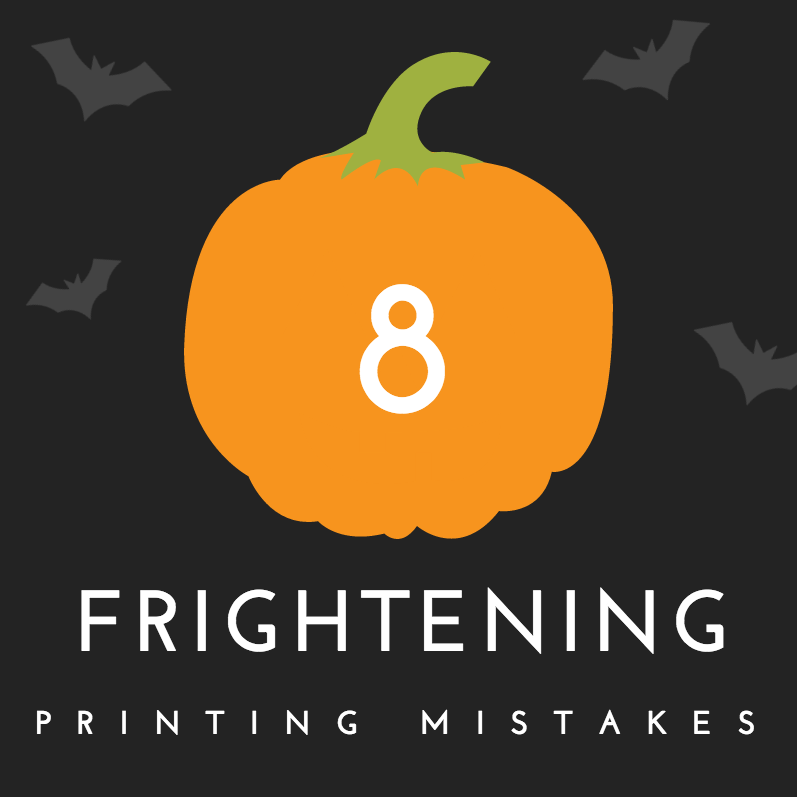
In honor of Halloween this weekend, we have gathered some scary printing mistakes that will haunt your dreams (and your bank account). Go ahead and save yourself a headache by reading these 8 common blunders.
Printing Mistake 1: Sending the wrong file type
At amp, we need PDFs to print your wonderful masterpieces. Not jpegs. Not PowerPoints. Not Word Documents. In most cases, it’s pretty easy to convert a design into a PDF. In others, not so much.
We also want high-resolution (300 dpi) PDF files for printing. We like this file type because all of the fonts and images are embedded. What you see will be the same as what we see. We can print documents between 150 dpi and 300 dpi, but everything will look best at the latter resolution. We can’t print anything with a higher resolution than 300 dpi. FYI: dpi stands for dots per inch.
Printing Mistake 2: Not sending bleed
If you want a color, a photo or anything to run off the edge of the piece, bleed must be added to it. If not, you might end up with a tiny sliver of white paper on the edges of your print products. We suggest 1/8″ (.125″) bleed all the way around the trim line. For example, a standard business card is 3.5×2, but the bleed size is 3.75×2.25.
Printing Mistake 3: Not being specific
You’d be surprised how many orders we receive that ask for “cool” or “awesome” business cards (or other paper product). While we can give you ideas (see our other blogs), it’s hard for us to design something without any guidelines. “Cool” is subjective. If you see something you like, tell us what you like about it, and we will design based off of your answer.
“Standard” is another word that gets tricky. While there are U.S. standard business card (3.5 x 2″) and letterhead (8.5 x 11″) sizes, there are no standard sizes for booklets, posters, invitations and brochures. It’s safer to give us exact dimensions so that we don’t print the wrong size. We will most likely catch you before we send your project to press, but it will still save you time and a headache to tell us your dimensions on the front end.
One more example: paper type and weight. Some customers assume we know he or she wants cover weight when we are really printing on text weight. Or, some customers want uncoated paper when we thought he or she meant silk paper. Finally, many customers forget to mention finishing. If you would like any type of lamination, UV coating, die cutting, etc. — we need to know on the front end. Especially if you want a correct quote up front.
The main point is: you can never be too specific! We love all the tiny, little details. The more, the better.
Printing Mistake 4: Designing a border too close to the edge
As most of you know, we don’t cut every brochure or card by hand; we cut in bulk. Our cutter is very precise, but it’s not perfect. Sometimes, it can be a 1/16th of an inch off. That doesn’t sound like much, but when your border is too close to the edge, it becomes painfully obvious. Thus, we recommend a border with enough safe space between it and the edge of the paper.
Printing Mistake 5: Not designing in CMYK
Before you start designing, you will want to know the color type your printer requires. We require everything in CMYK. We can print documents in PMS or RGB, but the colors will be slightly off. If Coca Cola printed some business cards in cherry red and some in a maroon color, it would be confusing to customers. It also looks unprofessional.
You won’t believe it, but we even need you to check your blacks. Make sure they are all 100% black as opposed to rich black, which is 100% of all four colors (that make black). The two blacks look very different on the press, and 100% black tends to look better.
Printing Mistake 6: Not giving yourself enough time for your project
When you know you will need printing for an event, know how much time your particular project requires. Certain types of finishing, such as die cutting, embossing and foil stamping, take much longer to complete than a basic printing job. Our turnaround time for basic print jobs is two days. We can complete certain projects, like business cards, in less time, but it will cost you.
Printing Mistake 7: Designing a gatefold with detailed panels
A gatefold can be a really neat design technique. However, because our cutter isn’t perfect, slight inconsistencies become very apparent with a gatefold. For example, horizontal stripes are very hard to align with a gatefold. We can try our hardest, but not all of the brochures will be perfect. Also, it might take longer if we have to reprint and/or re-cut your brochures in order to align the flaps perfectly.
The same goes for designing the back of an envelope. If you have a detailed pattern that spans the entire back of the envelope, the flap may not always align perfectly.
Printing Mistake 8: Not proofreading
If there’s one thing we want you to walk away with after reading this blog, it’s that proofreading is critical. Check for typos at least three times! It’s incredibly expensive to reprint 1,000 booklets because there was a small misspelling on page 23.

Were these scary printing mistakes helpful? Let us know!
